Vol 3 No. 04 TROPIC LIGHTNING NEWS January 22, 1968
Index
3RD
BRIGADE KILLS 382 VC
IN BATTLE NEAR SOUI CUT
Four battalions of Main Force Viet Cong attempted to overrun a 25th Inf
Div fire support base on Jan. 1 and 2, and lost 382 men in the abortive attack.
The battle took place at Soui Cut, some 90 kms from Saigon. The enemy launched
their attack on the afternoon of Jan. 1, hours before the termination of their
announced New Year's truce period. The Div's fire support base had been set up
only three days earlier.
The attack began with mortar and rocket grenade attacks in the afternoon and
evening. Then shortly before midnight, still well before the end of the truce,
four enemy battalions from the 271st and 272nd Main Force Viet Cong Regiments,
launched human wave assaults against the fire support base perimeter.
The defenders were members of the 25th Div's 3rd Bde who were in the process
of setting up a powerful fire support base at Soui Cut, only 12 kms from the
Cambodian border. (See Map Page 8)
The enemy was repelled with small arms, automatic weapons, hand grenades and
supporting fire. The tubes of the 105mm howitzers were lowered and fired
directly into the Viet Cong attackers.
It was only last March that men of the 3rd Bde, then the 3rd Bde. 4th Inf
Div, had killed 647 communists of these same Viet Cong Regiments in the battle
of Soui Tre. That battle is still the biggest one-day victory of the war.
Additional fire support for the battle at Soui Cut was provided by Army
helicopter gunships and Air Force tactical aircraft hitting enemy positions from
which they launched their assaults, and later enemy escape routes.
When the Viet Cong attempted to flee to the south and west at daybreak on
Jan. 2, these aircraft sprayed the jungle with thousands of rounds of machine
gun fire and air-delivered rockets.
The infantrymen found most of the enemy dead around the base camp perimeter.
U.S. casualties were listed as 23 killed and 153 wounded.
In addition to the 382 Viet Cong killed, the enemy lost 87 individual
(rifles, carbines and sub-machine guns) and 29 crew-served (machine guns,
mortars and recoilless rifles) weapons.
"Wolfhounds" Kill 191 VC
In Two Separate Actions
Five-hour Battle
2ND BDE - A battalion of North Vietnamese
regulars, under cover of a heavy mortar and RPG rocket barrage, attempted to
overrun the night location base of the 1st Bn, 27th, Inf "Wolfhounds," shortly
after midnight on Jan. 10.
The attack, which took place 9 kms northwest of Cu Chi, left 103 communist
soldiers dead. U.S. losses were five killed and 20 wounded.
During the five-hour battle the Wolfhounds and a battery of howitzers from
the lst Bn, 8th Arty, were supported by helicopter light fire teams, additional
artillery from Cu Chi and an Air Force "Spooky" flare ship.
The defenders poured thousands of small arms, automatic weapons rounds,
grenades and direct howitzer fire into the enemy. Several bodies were found
within the perimeter. The list of captured weapons included 5 RPG rocket
launchers with 36 rounds, 160 hand grenades, 5,000 rounds of small arms
ammunition, 14 other individual and 2 crew served weapons, and 50 complete sets
of web gear.
From captured documents, 2nd Bde officials learned that the enemy force was
from the K-18 NVA Battalion, who reportedly entered South Vietnam early last
May. It is the same unit that clashed with the Wolfhounds in the HoBo Woods
early in December.
Two-day Operation
2ND BDE - In two days of hard fighting Operation
Saratoga infantrymen killed 88 Viet Cong and captured five individual weapons
and a number of small arms ammunition and hand grenades.
Both battalions of the 2nd Bde's 27th Inf "Wolfhounds," struck enemy
positions in a multi-prong attack near the western banks of the Saigon River in
Binh Duong Province, 27 kms north-northwest of Saigon.
According to captured documents, the slain enemy were part of the hard core
2nd Go Mon and the 1st MR-4 Battalions.
Terrorist activities in and around the Saigon Area have been attributed to
those two units said a military intelligence official.
Heavy fighting broke out several times during the two-day operation in which
the Wolfhounds were supported by a battery of howitzers from the 1st Bn, 8th
Arty, and gunships from the 116th Aslt. Hel. Co. Numerous Air Force tactical
airstrikes were flown in support of the ground troops.
At one point infantrymen uncovered a company-size base camp which contained
what one officer called "he best built bunkers ever seen in this area."
The now dry lowlands were dotted with thick hedgerows which completely
concealed dozens of heavily reenforced enemy bunkers, tied together by tunnels
and trench lines.
This "Break" Becomes
Extremely Lucky Break
2ND BDE - A company of U.S. infantrymen
searching for Viet Cong in the Ho Bo Woods, 54 kms north-northwest of Saigon,
took what they termed as the luckiest break they ever got.
A company of the 2nd Bn, 27th Inf "Wolfhounds," had been on the move for an
hour, when CPT Peter M. Elson of Mount Vernon, Ohio, called for a break.
As the words "BREAK" were passed back through the ranks, automatic weapons
fire suddenly tore through the heavy undergrowth. Two men were wounded by the
enemy bullets which came from what was later found to be an enemy company-sized
base camp with heavily reinforced and well hidden bunkers.
Elson reporting on the action, said that the Viet Cong apparently
misunderstood the word "BREAK" and opened fire prematurely. He also stated that
the Wolfhound casualties would have been a lot heavier had they been closer to
the bunkers.
Two companies of Wolfhounds were brought in to reinforce Elson's unit while
artillery and Air Force tactical airstrikes hit the enemy's base camp.
After the Viet Cong withdrew, a check of the area disclosed 42 Viet Cong
bodies. The Wolfhounds had four men killed and 16 wounded.
Div Commander Presents
Awards To "Manchus"
1ST BDE - The 25th Inf Div Commander, MG F. K. Mearns, recently visited the
1st Bde's forward support headquarters at Katum, to present awards for heroism
in actions against hostile forces to personnel of the 4th Bn, 9th Inf "Manchus."
The medal winners were 1LT Ronald Reedy, who received the Bronze Star with
"V" device for action in August at the Rattle of Phu Hoa Dong, and SSG Edward
Henderson, who was awarded the Silver Star for heroism against Viet Cong forces
in September in the Ho Bo Woods, during Operation Barking Sands.
Documents, Base Camps
Discovered
1ST BDE - Soldiers of the 4th Bn, 9th Inf "Manchus,"
slashing through a Viet Cong stronghold 40 kms northwest of Tay Ninh in
conjunction with Operation Yellowstone, have killed 70 enemy troops and
destroyed five of their base camps.
The camps, all battalion size, were heavily secured by numerous networks of
wires leading to CHICOM command detonated mines.
On searching the camps the Manchus discovered secret documents, 25 pounds of
hand-painted propaganda posters, and 52 tons of rice - an amount estimated to
spell the difference between prosperity or starvation for an enemy regimental
force for three months.
COL John Henchmann, Manchu battalion commander, said, "This area is literally
swarming with Viet Cong, and we're smack in the middle. The fact that our
casualties are practically nil is a tribute to the ability of these fine young
soldiers."
Thus far in Operation Yellowstone, the enemy has continuously harassed Manchu
positions with day and night mortar attacks.
Enemy Mortar Crew Slain
CU CHI - Courage and a pair of sharp eyes are
credited with breaking up a possible attack on the Cu Chi base camp of the 25th
Inf Div.
When smoke cleared from the ensuing action, the 3rd Sqdn, 4th Cav's D Trp
counted five enemy dead and captured a mortar. Discarded bloody clothing and
web gear led squadron officers to believe enemy losses were higher.
The initial sighting of the enemy position was made by WO Jeffrey Halliday,
an aircraft commander, while he and a second helicopter were flying a late
afternoon perimeter patrol.
Halliday, reporting on the encounter, said he was informed by squadron
operations that a team was not available to apprehend and question the men who
up to that time were only suspects.
Rather than wait, Halliday's crew volunteered to do the checking while the
second aircraft orbited overhead.
As Halliday hovered over the area, SP5 Thomas Lange, the crew chief, grabbed
his M-16 and jumped to the ground.
According to Halliday, as the crew chief moved toward one of the hidden
suspects, the man jumped up and threw a grenade which exploded.
The aircraft commander swung the chopper around and sprayed the area with
mini-gun fire, then dropped down and picked up Lange who was also firing.
The second gunship remained overhead, firing rockets and machine guns into
the enemy's position. A short time later an Aero Rifle Plt arrived and swept
through the area, finding the five bodies and bloody clothing.
Page 2 TROPIC LIGHTNING NEWS January 22, 1968
Decorated
| Silver Star | |
|
LTC Thomas A. Ware Jr., HHC, 4th Bn, 9th Inf CPT Alfred W. Baker, Co B, 4th Bn, 9th Inf CPT Peter M. Elson, Co D, 2nd Bn, 27th Inf CPT Donald C. De Caper, B Btry, 1st Bn, 8th Arty PSG Bob H. Smith, Co B, 2nd Bn, 12th Inf |
SSG Cornell
Johnson Jr., Co B, 4th Bn, 9th Inf SSG Douglas Stanfield, HBHS Biry, 3rd Bn, 13th Arty SSG Gary R. Pearse, Co A, 2nd Bn, 27th Inf SP4 Charles W. Page, Co A, 2nd Bn, 12th Inf |
Distinguished Flying Cross |
|
|
CPT Paul G. Larish, 116th AsIt Hall Co, 269th Avn Bn 1LT Antony M. Coggesholl, 116th Aslt Co, 269th Avn Bn 1LT Robert D. Frazier 116th Aslt Hel Co, 269th Avn Bn WO1 William R. Croucher, 116th Ash Hel Co, 269th Avn Bn |
WO1 Michael L.
Cheney, 116th Asti Hel Co, 269th Avn Bn WO1 Wesley J. Ashabranner, D Trp, 3rd Sgdn, 4th Cav WO1 William M. Gold Jr., D Trp, 3rd Sgdn, 4th Cav WO1 Gerald F. Finch, 116th Aslt, Hel Co, 269th Avn Bn |
Bronze Star Medal (Valor) |
|
|
LTC Fremont B. Hodson, HHC, 2nd Bde LTC Thomas H. Ball, H&HS Btry, 3rd Bn, 13th Arty MAJ Victor A. Weber, HHC, 2nd Bde CPT William L. Heiberg, B Btry, 3rd Bn, 13th Arty 1LT Aubrey B. Stacy, Co A, 4th Bn, 23rd Inf 1SG Walter P. Jackson, Co C, 4th Bn (Mech), 23rd Inf SFC Roy J. Hatfield, C Btry, 3rd Bn, 13th Arty PSG Boswald W. Sanders, Co A, 2nd Bn, 22nd Inf PSG Otis R. Kraft, Co C, 4th Bn (Mech), 23rd Inf SSG Vaughn M. Angell, Co A, 2nd Bn, 34th Armor SSG J.C. Chambers, Co A, 2nd Bn, 34th Armor SSG Gerardo Marrero-Maldonado, Co A. 4th Bn, 9th Inf SGT Timothy Bodecker, Co C, 65th Engr Bn SGT Raymond P. Engle, Co D, 4th Bn, 9th Inf |
SP4 Michael J. Muesing, Co B, 2nd On, 22nd Inf SP4 Robert W. Cooper, Co A, 2nd Bn, 34th Armor SP4 Joseph E. Koshinsky, Co A, 2nd Bn, 34th Armor SP4 Murlyn N. Cole, Co A, 2nd Bn, 34th Armor SP4 Steve V. Finney, Co A, 2nd Bn, 34th Armor PFC Graythorn C. Jamison, Co D, 4th Bo, 9th Inf PFC David D. Cline, Co D, 4th Bn, 91h Inf PFC Donald F. Comfort, Co A, 65th Engr On PFC Ronnie E. Byrd, 3rd Bn, 13th Arty PFC Michael 0' Donell, Co D, 2nd Bn, 27th Inf PFC Leonce Arabia, Co A, 2nd Bn, 34th Armor PFC Wendell Johnson, Co D, 2nd Bn, 12th Inf PFC Michael O'Donell, Co D, 2nd Bn, 27th Inf |
Bronze Star Medal (Merit) |
|
|
LTC Richard C. Rogers, HHC, 2nd Bde LTC Noel L. Bergeron, HHC, 25th Inf Div MAJ Ervin N. Page, HHC, 25th Inf Div MAJ James L. Mitchell, HHD, 25th Avn Bn MAJ Robbie G. Pedigo, 341st Avn Det MAJ Clifford W. Steelman, HHC, 2nd Bde CPT Carl H. Burton, HHC, 1st Bde CPT Michael J. Bender, Co A, 25th S&T Bn CPT James E. Meador, HHC, 2nd Bde CPT Dennis L. Fontaine, HHC, 25th Inf Div CPT Walter H. McLendon, HHD, 25th Avn Bn CPT Johnny C. Trammell, HHD, 25th Avn On CPT Doyling G. Patterson, HHC, 251h S&T Bn CPT Thomas M. Jones, HHB, 25th Inf Div Arty MSG Charles O. Gautreau, 25th Admin Co 1SG Robert Kron, Co B, 4th Bn, 9th Inf MSG Millard Orick Jr., HHC, 3rd Bde PSG Joseph R. Smith, 25th Admin Co SSG Gene Corley, 341st Avn Bn |
SSG Andrew J. Mankowski, HHC, 4th Bn, 9th Inf SSG Charles W. Rinehart, HHD, 125th Sig Bn SSG Virgle, H. Woodrow, Co A, 2nd Bn, 27th Inf SGT Marion Emmery, HHC, 25th Inf Div SP5 Richard L. Foster, HHC, 25th Inf Div SP5 Thomas Rowe, 25th Admin Co SGT Robert L. Bonner, Co A, 4th Bn, 9th Inf SGT James L. Conley, Co A, 4th Bn, 9th Inf SGT Joseph J. Ingram, Co B, 25th S&T Bn SP5 Richard L. Kuckawich, HHC, 2nd Bn, 27th Inf SGT Willie F. Roberts, Co A, 4th Bn, 9th Inf SGT Raymond L. Russell, HHC, 2nd Bde SGT Robert A. Stahl, HHC, 2nd Bde SGT Floyd E. Chamberlain, HHD, 125th Sig Bn SGT Jesse J. Craig, Co B, 1st Bn, 27th Inf SP5 Darrell D. Strong, HHC, 4th Bn (Mech), 23rd Inf SP4 Stephen M. Dillard, 25th Admin Co SP4 Leonard Pack, HHB, 25th Inf Div Arty |
Apollo Crewmen Named
Manned Spacecraft Center officials have announced the names of the three-man
crew for the third manned Apollo space mission, scheduled for early 1969.
Commander for the third flight crew will be Air Force Lt. Col. Frank Borman,
who was command pilot on the 14-day Gemini 7 mission. Command module pilot will
be Air Force Lt. Col. Michael Collins, and lunar module pilot will be Air Force
Maj. William A. Anders.
Plans for the third manned mission call for an earth orbit flight simulation
of the lunar landing mission. Events of the lunar mission will be conducted in
the same sequence and at the same relative times during this mission.
EDITORIAL
More Money - More Savings
You, the American serviceman, are richer today than ever before.
The Uniformed Services Pay Act of 1967, signed into law by the President Dec.
16, has given you the fifth pay raise in as many years, supplemented by other
improvements in the military pay program.
First, Congressional action has provided you with a 6.8 per cent per annum
increase in your basic pay, and second, included a number of other provisions
such as:
• Increased Dependents Assistance Act allowances for certain personnel in the
lower pay grades;
• Authorization of a basic allowance for quarters (BAQ) and dislocation
allowances for certain bachelor personnel in connection with permanent changes
of station;
• Creation of a special basic pay rate of $844.20 a month for the senior NCO
position of each of the services;
• Travel and transportation allowances for one round trip from a continental
U.S. medical treatment facility to a point selected by the serviceman and
approved by his Service Secretary when traveling during convalescent leave
resulting from illness or injury incurred while eligible for hostile fire pay.
That's not all. The pay bill also provides for future military pay increases
tied in both date and amount to average future increases granted federal civil
service classified employees.
Now, you have more money in your pocket. The question is - what are you
going to do with this windfall?
You could buy any number of attractive items currently on sale in the post
exchange or offered through civilian outlets off-base. You could pay off
current indebtedness and declare yourself financially solvent.
Or, you could invest in your own future and save through two sound savings
programs offered the serviceman for the wise and prudent use of his money - U.S.
Savings Bonds and Uniformed Services Savings Deposits.
Consider, while counting that pay increase, that the new "Freedom Shares,"
which mature in four and a half years and earn 4.74 per cent interest, are sold
as packages with Series E Savings Bonds. With $39, you can buy a $26 Freedom
Share and a $26 Series E bond.
If overseas or about to be transferred outside the continental U.S. limits,
you can use the Uniformed Services Savings Deposit Program which pays 10 per
cent interest annually on deposits up to $10,000.
Make that 6.6 per cent increase work for you, while remaining within the same
budget you operated under before the pay raise. (AFPS)
30,000 Call Home Over
MARS Radio
The Military Affiliate Radio System (MARS) in Vietnam was in full swing
during the holiday season relaying calls to the United States.
During December, the stations handled more than 30,000 calls and relayed more
than 50,000 messages from servicemen there.
The MARS stations in the combat zone got their start in December 1965 when
the Vietnamese government authorized operations and 15 stations were opened.
Now, some 60 stations are located in all parts of Vietnam, and two of them are
aboard the hospital ships USS Repose and USS Sanctuary.
The stations are linked to the United States by 38 radio frequencies through
"gateway" stations in Hawaii, Alaska and nearly 29,000 civilian affiliated
stations in the U.S.
The civilian affiliates receiving radio messages forward them by commercial
lines. The only cost to the serviceman is the price of a collect call from the
stateside station to the recipient.
Worldwide, there are about 760 MARS stations.
The TROPIC LIGHTNING NEWS is an authorized publication of the 25th Infantry Division. It is published weekly for all division units in the Republic of Vietnam by the Information Office, 25th Infantry Division, APO San Francisco 96225. Army News Features, Army Photo Features, Armed Forces Press Service and Armed Forces News Bureau material are used. Views and opinions expressed are not necessarily those of the Department of the Army. Printed in Tokyo, Japan, by Pacific Stars and Stripes.
MG F. K. Mearns . . . . . . . . . . . . . . . Commanding General
MAJ. Bernard S. Rhees . . . . . . . . . . Information Officer
1LT Larry Rottmann . . . . . . . . . . . . . Officer-in-Charge
SSG Dave Wilkinson . . . . . . . . . . . . Editor
SP4 Dave Cushman . . . . . . . . . . . . . Editorial Assistant
Page 3 TROPIC LIGHTNING NEWS January 22, 1968
Now Medical APC
follows Infantry To Field
By SP4 Jim Friar
3RD BDE - The high quality of medical treatment
and the speed in which casualties are evacuated to rear areas are well known
characteristics of the war in Vietnam. Usually within minutes after a casualty
is sustained, a medical evacuation helicopter (MEDEVAC) "dustoff" is on the
scene, lifting the wounded men out of the jungle and into the nearest hospital
facility. At times however, multiple casualties, heavy, impenetrable jungle, or
unsecure landing zones prevent the immediate aerial evacuation of the wounded.
In these cases, continuing loss of blood or the need for sophisticated equipment
not available to the line medic can result in higher casualties from wounds.
The 2nd Bn (Mech), 22nd Inf, is fortunate to be able to have a medical
armored personnel carrier accompany it in the field. Led by CPT Jack Coyer, the
"Hemostat Hilton" armored personnel carrier provides the mobility for a doctor
to accompany the battalion in the field with the capacity for medical supplies
necessary to provide instantaneous broad scale medical care to injured soldiers.
There are presently four other personnel attached to the medical APC. SP5
Edvent Grinnell from Tillicum, Wash., is the enlisted man in charge and is a
licensed practical nurse. SP5 Joe Passillas from Cuttler. Calif., spent eight
months on the line before transferring to the battalion aid station. Joe is
also the driver and in his spare time has to perform the usual maintenance
necessary to keep the APC in tip-top shape. SP4 Warren Vance, who spent four
months in a line platoon and PFC Chuck Romans, from Chillicothe, Ohio, are the
newest members of the group.
Besides carrying a five or six-man medical team into field, the APC is able
to carry everything that a normal battalion aid station would have in base
camp. In addition to carrying extra bandages and medical supplies used by the
line medics, equipment such as whole blood, intravenous solutions, sterile
surgical tools for minor surgery in the field, and a complete pharmacy are at
the disposal of Dr. Coyer and his staff. Since a mechanized battalion usually
spends most of their time in the field, this enables the men on sick call to be
treated in the field rather than being sent to base camp for treatment.
When the "Triple Deuces" lager for the night, the first thing done to the
"Hemostat Hilton" is to put up the tent attached to the back of the APC. When
darkness comes, with its inherent light discipline, the dry lightproof tent
provides a place to treat casualties.
Most of the time the duties consist of having sick call in the morning and
night, and if need be, preparing casualties for extraction. At times, the full
capabilities have been needed to give treatment to multiple battle casualties.
Last year, when the "Triple Deuce" relieved their sister battalions at
Landing Zone Gold, the medical track came in with the battalion and quickly
became the focal point for treatment and extraction of the wounded. Over 100
soldiers from the battalions were treated by the "Hemostat Hilton."
On Operation Diamondhead the battalion command post moved into a fire support
base 7 kms south of Dan Tieng. During the night the area was mortared. Over 30
casualties were treated by the aid station, put in litters with blankets and
airlifted to the hospital. Field transfusions were performed on the spot.
"Fortunately the occurrences are few and far between," said Coyer, "but there
have been a few injuries where immediate availability of blood and surgical
first aid have probably meant the difference between life and death for the
injured personnel."
Another advantage of the aid station is its capacity to hold MEDCAPs without
requiring air mobile transportation to fly in the men and equipment. Facilities
are available to treat virtually all the people except those requiring surgery,
x-rays, or long term treatment.
With the doctor and senior medical specialist always in the field, the line
medics also have the opportunity to refresh their memories on little used
techniques. When the Triple Deuces lager for the night or stay in the same camp
for a few days the "Doc" will call the men together and go over the various
life-saving steps and new techniques available. The constant cycle of
inexperienced medics entering the battalion has made this training an important
part of the medics overall ability to perform under fire.
| MEDICAL APC - Men of the "Triple Deuces" perform a little first aid on their APC. In addition to caring for the men of the battalion, the "Hemostat Hilton" crew pulls its own vehicle maintenance. (Photo by SP4 James Friar) |
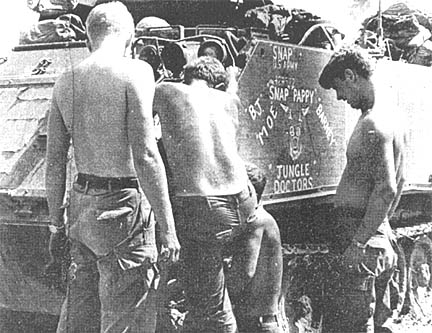 |
Viet Cong Wheat Goes
To Orphans
2ND BDE - Five tons of captured Viet Cong rice
was transferred from the 25th Div's Helping Hand storehouse to the Catholic
orphanage in Thu Duc, in what Father John Thien termed as reflective of the
attitude of the American people.
Father Thien is the administrator and spiritual leader of the orphanage which
he and Doctor Tom Dooley founded in 1956.
1LT Phillip C. Grinton, 2nd Bde civil affairs officer who headed the project,
stated that word of the immediate need for food was received at division
headquarters early in December and the rice had been transferred to Thu Duc by
truck.
Expressing his gratitude for the food, Father Thien said, "It is appropriate
that this kindness is evidenced in the Christmas season. I want to thank you on
behalf of the children, the other fathers and myself for your selfless gesture."
Emphasizing the Father's statement, Grinton feels that rice is more than a
gesture in Vietnam - it means life or death to people. Grinton then explained
that this particular rice had been uncovered in the Iron Triangle during
Operation Atlanta by elements of the 2nd Bde.
About the origin of the rice, Father Thien said, "It is fitting that children
orphaned by the Viet Cong should benefit from the rice captured from the Viet
Cong."
Artillery Medic Aids
Civilian
DIV ARTY - A Vietnamese civilian was hurt in an
accident recently in the village of Go Dau Ha and the call for help was answered
by Alpha Btry of the 3rd Bn, 13th Arty.
SP4 John Eckmann from Collinsville, Ill., explained, "I was returning from Go
Dau Ha with Specialist Johnson when we passed a crowd of Vietnamese standing on
the side of the road. I looked closer and saw a man lying in a ditch."
He stopped the truck and learned that the elderly man was thrown from his
motor scooter by a passing vehicle.
"The man was badly hurt and I thought his leg was broken so we sent for the
battery medic," recalled Eckmann.
Medical Corpsman Robert Blount arrived with several cannoneers a few minutes
later from the nearby fire support base occupied by A Btry.
"When I arrived the man was still sprawled in the ditch but some Vietnamese
people had wrapped crude bandages around his thigh in an effort to staunch the
flow of blood," said Blount. It took Blount's practiced hands only a few short
minutes to aid his patient.
The artillerymen then placed the injured man on a stretcher and transported
him to a Vietnamese hospital where his condition was later described as good.
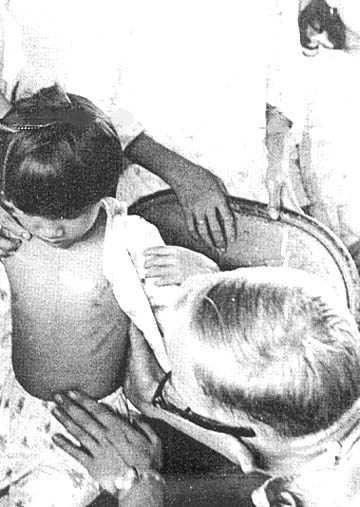 |
ROVING DOCTOR - Dr. Jack Coyer, the doctor with the "Hemostat Hilton," checks out a little Vietnamese girl during one of the many MEDCAPs held by the roving medical track. (Photo by SP4 James Friar) |
25th MEDCAP Sets New
Record
2ND BDE - When a civil affairs team held an
impromptu Medical Civic Action Program (MEDCAP) in the tiny hamlet of Soui Da,
112 kms northwest of Saigon, they didn't realize that it would turn out to be
one of the largest single MEDCAPs in the history of the 25th Div.
Shortly after the 1st Bn (Mech), 5th Inf, moved into Soui Da at the start of
Operation Yellowstone, civil affairs personnel began planning activities for the
hamlet.
Civil Affairs Officer 1LT Stan McKee from Atlanta, Ga., explained that his
team set up the MEDCAP in the village square without the benefit of prior
announcements.
As one medic exclaimed, "The place looked deserted and the chances for a good
MEDCAP certainly looked slim."
"The first thing I did," says McKee "was find the village chief, and through
an interpreter I explained what we were there for."
Given a loudspeaker, the chief walked through the hamlet announcing the
MEDCAP. McKee described the initial group of patients as a trickle which
increased until it became a steady flow that lasted for four hours.
By the end of the day, McKee reported that his team had treated 486 patients
and given out 500 bars of soap, several pounds of candy and 2,000 agricultural
and livestock pamphlets.
Page 4-5 TROPIC LIGHTNING NEWS January 22, 1968
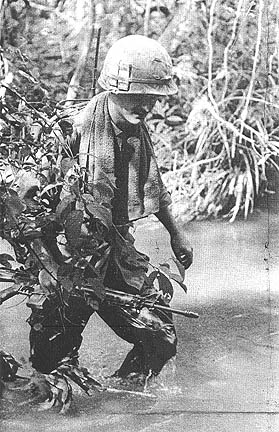 |
3RD BN, 22ND INF GI CROSSES STREAM. (PHOTO BY SP4 PETE EARL) |
| 2ND BN, 12TH INF IN STICKS. (PHOTO BY SP4 JOE HETTERMANN) |
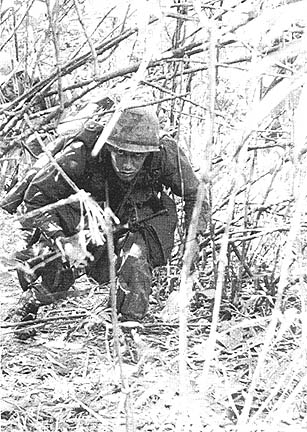 |
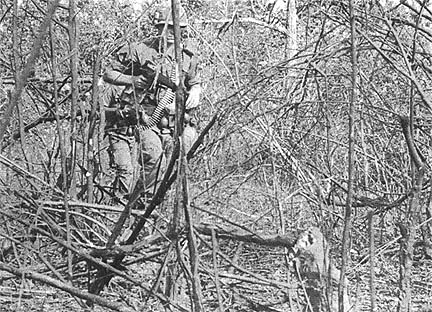 |
ROUGH GOING FOR A 1ST BN, 27TH INF SOLDIER. (PHOTO BY SP4 GARY GATLIFF) |
| MEN OF THE 3RD BN, 22ND INF, CROSS A STREAM. (PHOTO BY SP4 PETE EARL) |
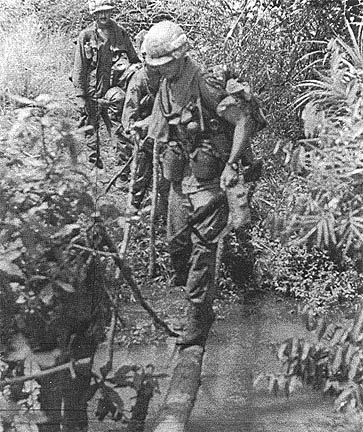 |
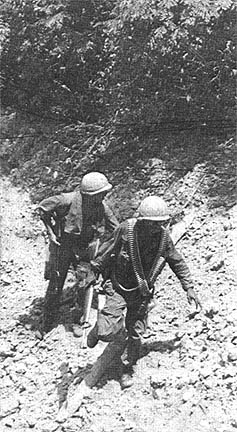 |
2ND BN, 14TH INF. (PHOTO BY SP4 JOHN SEYMOUR) |
| A 2ND BN, 27TH INF SOLDIER HUGS THE GROUND DURING OPERATION ATLANTA. (PHOTO BY SP4 JOE CAREY) |
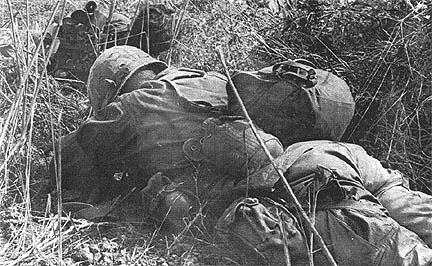 |
Page 6 TROPIC LIGHTNING NEWS January 22, 1968
Truce Violations Delay
GI's Meal
CU CHI - Viet Cong in the Boi Loi Woods broke
the Christmas truce and delayed Christmas Dinner three hours for cavalrymen of
the 25th Div operating 45 kms northwest of Saigon.
Alpha Troop, 3rd Sqdn, 4th Cav, had been operating on Highway 19 southwest of
Tay Ninh City before and during the Christmas Truce. There had been several
incidents prior to the truce and a large amount of rice and assorted building
materials had been discovered.
CPT Louis J. Sturbois of Cheyenne, Wyo., the troop commander, instructed his
men not to recon by fire during the truce in accordance with policy.
Tank 26 was outposting a sector of the small road on Christmas morning when
it was hit by a RPG-2 antitank rocket. After elements of the troop returned
fire the area was thoroughly searched with negative results.
At 11:30 a.m., the troop's first sergeant sent a truck to the various
platoons with Christmas presents from the American Red Cross. The troop
commander in one armored personnel carrier (APC) and the executive officer, 1LT
Dean Guynes of Hazelhurst, Miss., in another APC, escorted the truck.
At 12:10 a.m. the Viet Cong fired another rocket from the side of the road
hitting Sturbois' right number 4 road wheel. The rocket passed under the
personnel carrier and knocked out road wheels on the left side of the machine.
No one was hurt.
Sturbois' machine gunner, SP4 Nery J. Brennis of Baysmoni, P.R., returned
fire immediately.
"I am convinced that Brennis got the man," Sturbois said. "He sprayed the
area from which we could still see smoke from the rocket launcher."
Before the area could be reconned, the troop's command post in position up
the road, came under RPG-2 and small arms fire. Gunships and rocket ships from
the Sgdn's Delta Trp (Air) were called in. They received fire.
The firelight continued for another hour and a half. A troop spokesman
estimated the enemy force to be in excess of 30.
After the fireworks, Sturbois directed an extensive search of the entire
area. The cavalrymen found one VC KIA, one CHICOM AK-50 with four magazines,
and several documents.
The squadron intelligence officer, CPT William Coomer of Fort Thomas, Ky.,
identified the force as elements from the 93rd Rear Service Group from the
captured documents. He has been in the field with the troop the entire week.
During the attacks and the firelight, Christmas dinner was delayed. "The
mess sergeant and his men had been up until 4:30 a.m. Christmas morning
preparing it," Sturbois said. The troop's mess had been moved to the field
during the operation.
After an exciting Christmas day, the men of Alpha Trp set down at 3 p.m. to a
meal of turkey, cranberry jelly, sweet potatoes and pumpkin pie.
"It was a fantastically good meal," said Sturbois, "and well earned," he
added.
These VC Weapons
Rather Odd
2ND BDE - Tunnel rats have found some old and
rather odd weapons in the Iron Triangle, according to one 25th Div company
commander.
CPT Peter Gleezer, the 1st Bn, 27th Inf's Alpha Co commander from Alexandria,
Va., says his men are turning up an odd assortment of weapons during search and
destroy missions, 45 kms north-northwest of Saigon, where the division is
conducting Operation Atlanta.
"We went through one tunnel and found a 1916 French rifle with a barrel as
long as one of the old Kentucky Long-Rifles," explains Gleezer. "Old Charlie
must have had a hard time getting ammo for it, because it had an AK-47 round in
the chamber that looked like it had exploded when it was fired."
Gleezer also reported that his company found a 1917 Winchester rifle with a
carbine stock and a homemade barrel, as well as a .25 cal. pistol and a .45 cal.
automatic with a nail for a firing pin.
"About all these weapons are good for," Gleezer feels, "are for souvenirs."
COL Brownell Is Spt Cmd
CO
CU CHI - COL James R. Brownell assumed command
of Spt Cmd, 25th Inf Div, in ceremonies recently conducted at that
headquarters. He replaces COL Leonard R. Daems Jr., who has assumed command of
the 3rd Bde.
COL Brownell joins the 25th Inf Div following an assignment with the Office
of the Joint Chiefs of Staff in Washington, D.C. Prior to this, he has served
with overseas commands in Europe, Japan and Korea, and has been awarded the
Legion of Merit and Army Commendation Ribbon with oak leaf cluster.
COL Brownell is a graduate of the U.S. Military Academy, the Air University,
the Air War College, and the Command and General Staff College. He has received
a master of science degree in Civil Engineering from Massachusetts Institute of
Technology and a master of arts degree in International Affairs from George
Washington University.
They Zap Big Python
2ND BDE - "Hey, there's a snake up here."
"How big?"
"Don't know."
"It's coming your way."
PFC Jon D. Wrentmore of Cleveland, jumped up on a log and swung the muzzle of
his M-16 in every direction from which the snake might be slithering.
"I see it," yelled PFC Kenneth Green Jr. of Jonesboro, Ark., as he joined
Wrentmore on the log.
After firing a magazine of M-16 ammunition and two-M-79. grenades, the two
25th Div infantrymen left their perch and checked the battlefield.
"He measured 12 feet," says Wrentmore.
They packed the python in a plastic bag and carried it back to the 2nd Bn,
27th Inf's base camp.
To the victor go the spoils.
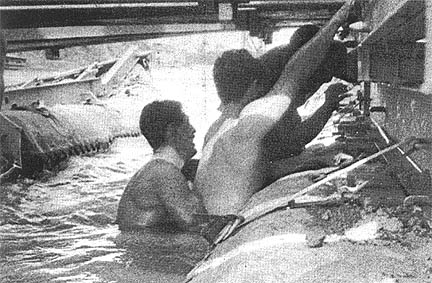 |
IN THE SWIM - Men from Co D, 65th Engr Bn, struggle against a river current to repair a pontoon bridge near the 25th Div's 3rd Bde base camp at Dau Tieng. (Photo by SP4 James O'Neil) |
Page 7 TROPIC LIGHTNING NEWS January 22, 1968
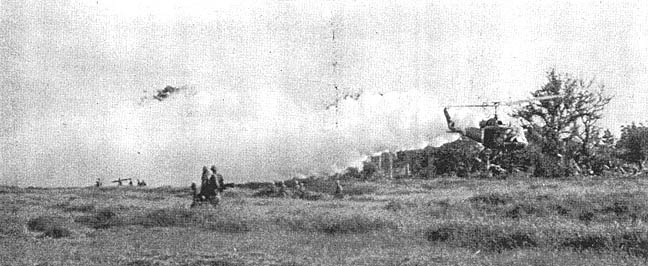 |
| HIDDEN FROM THE ENEMY - Soldiers from the 2nd Bn, 27th Inf "Wolfhounds," move from a landing zone toward a wooded area screened by smoke from a helicopter. The assault took place near the Oriental River on Operation Saratoga. (Photo by SP4 Joe Carey) |
554th Engineers Resurface Vietnam's Route 19
554TH ENGR BN - Traffic on Route QL 19 is moving
a lot smoother now due to the efforts of the 554th Engr Bn (Const).
Route 19 connects Trang Bang with Xom Bao Don. In early December, 125 men
with 45 earthmoving vehicles from Bravo and Alpha companies, convoyed from their
Cu Chi base camp to a camp near the village of Go Dau Ha. Their mission was to
repair and resurface Route 19, using a laterite and peneprime process.
Shortly after setting up camp, the engineers conducted soil tests which
showed laterite deposits located near the road which was to be resurfaced.
Dozers were employed to remove the over-burden under which the laterite was
located. Front-end bucket loaders were then able to move in and begin loading
the dump trucks with laterite. In the ensuing weeks, the dump trucks hauled
over 9,000 cubic yards of laterite from this and other pits which were later
opened.
The process of resurfacing a road of this type, begins as the dump trucks
deliver the laterite. Then, graders and dozers take over, spreading, widening,
upgrading and smoothing out the new surface. Later, a peneprime solution is
sprayed on the road to help solidify the surface and maintain dust control.
The engineers placed a total of 320 feet of steel culvert under the roadway
during the operation in order to improve drainage.
Even though they had 45 pieces of heavy equipment operating daily on the
road, the engineers made sure that Route 19 remained open to local traffic
throughout the entire period.
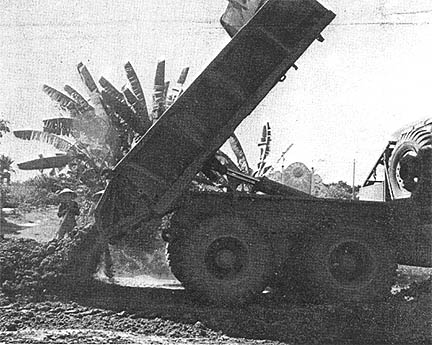 |
LATERITE LOAD - Because of its iron-rich content, laterite is best suited for secondary road material. Here another load is dumped on Route 19 by the 554th Engr Bn. (Photo by SP4 Thomas Keller) |
VC Using Old "Medic Cry"
Trick
1ST BDE - A Viet Cong trick of trying to get a
medic out in the open, almost cost SP4 Randall (Doe) Dunphy of Seattle his life
when he started to answer a call for help.
At the peak of an enemy assault on the 25th Div's 4th Bn, 9th Inf "Manchu,"
base camp at Bo Tuc, 128 kms north-northwest of Saigon in War Zone C, Dunphy was
in a command bunker scanning the area to his front for Viet Cong.
"When I heard a yell for a medic," explained Dunphy, "I started out towards
the sound, when bullets started zipping by me. I dove for my bunker and
realized that Charlie was playing games with me.
"That was the last game those VC will ever play," snapped machine gunner SP4
Charles Woodruff. "When I heard those shots, I opened up with my M-60 to cover
Doc."
At daybreak, the men found four Viet Cong bodies not more than 20 feet from
their position.
"That's what I call close-in fighting," says Woodruff.
Dunphy mumbled, "I'd say it was a close call."
| HAMMERS AWAY - SP4 Thomas Joy mans a jackhammer on Route 19 near Trang Bang during a resurfacing operation conducted by the 554th Engr Bn. (Photo by SP4 Thomas Keller) | 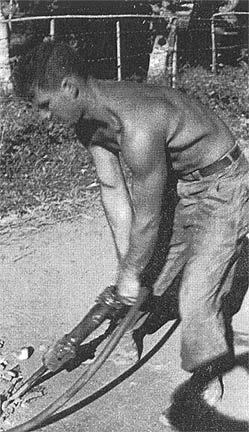 |
Page 8 TROPIC LIGHTNING NEWS January 22, 1968
Enemy Kept On The Move During 1967
by SFC Roy Doupe
CU CHI - The 25th (Tropic Lightning) Inf Div
ranged far and wide over the four provinces west and northwest of Saigon to the
Cambodian border in its continuous search to find and destroy the elusive Viet
Cong foe during 1967.
From its home base in Hau Nghia Province the division staged operations,
ranging from company-size search and destroy missions to multi-division
operations throughout the adjoining provinces of Long An, Tay Ninh and Binh
Dunne. And, as the year drew to a close, combat-hardened elements of the 2nd
and 3rd Bdes were deployed north in Phuoc Long Province to counteract a flare-up
of communist activity in that area.
During operations such as Fairfax, Gadsden, Cedar Falls, Junction City and
Manhattan the Tropic Lightning troopers penetrated the Pineapple Patch, the
Filhol Plantation, the Iron Triangle, the Ho Bo and Boi Loi Woods, the Michelin
Plantation and War Zone C where VC influence had reigned supreme for 25 years.
They met and defeated the enemy in his own back yard, destroying fortification
systems and base camps that had taken him years to construct and, through
continuous and relentless pursuit, denied him the time needed to build new areas
where he could rest and recoup his losses.
The Pineapple Patch, once a prosperous plantation that was reduced to a swamp
by the VC and heavily fortified, is now merely a swamp filled with destroyed
bunkers.
The Filhol Plantation and the Ho Bo and Boi Loi Woods, sanctuaries where the
VC formerly mounted their raids on Saigon and retreats where he could lick his
wounds and rest and recuperate for further terrorist activities, are now just
names on a map as engineer land clearing teams have laid low the rubber trees
and dense undergrowth on approximately 17,000 acres.
In addition to the major operations, each brigade conducted a monsoon
offensive, that started in May and ended in November. The 1st Bde's Operation
Barking Sands covered the north half of Hau Nghia Province. The 2nd Bde
conducted Operation Kolekole in the rest of Hau Nghia and Long An Provinces
while the 3rd Bde, during Operation Diamond Head, held its combat assault and
Revolutionary Development missions in Tay Ninh Province and northwestern Binh
Duong Province.
Since the beginning of the year the 25th Inf Div has destroyed more than 20
VC base camps while killing more than 4,086 Viet Cong. Other figures show that
25,000 fortifications and 1,900 tunnels were found and blown up with an
additional 10,700 meters of tunnels destroyed.
Among the myriad items of material that were captured and either destroyed or
evacuated were: 3,113 tons of rice, 7,900 mines and booby traps, 2,147
individual weapons and 668,408 rounds of small arms ammunition.
An integral part of the combat operations were the pacification and
Revolutionary Development programs aimed at winning the confidence of the people
of the provinces. Medical Civic Action Programs (MEDCAPs) were conducted
throughout the division's area of operations and 148,000 persons were treated
for illnesses ranging from the more serious sicknesses to minor cuts and
scratches.
Surveys of villages were made to determine their needs, schools were rebuilt
or repaired, dispensaries were opened, wells were dug or cleaned out to insure
an adequate water supply. Whenever possible the local villagers supplied the
labor but when the project was beyond their capabilities Tropic Lightning
troopers stepped in to get the job done. The whole program was designed to
demonstrate to the Vietnamese people that the division is here to help them
rebuild their country instead of destroy it as VC propaganda had led them to
believe.
Two of the most notable accomplishments during the year occurred during
Operation Diamond Head, at Dau Tieng In Tay Ninh Province, and Barking Sands, at
Phu Hoa Dong in Binh Duong Province.
The VC used three villages near the Div's 3rd Bde base camp at Dan Tieng as
stopping points for supply trains headed for War Zone C. To eliminate these
rest stops the 334 residents of the villages were relocated to the resettlement
area at Lai Thieu just outside Saigon. Nothing was left behind as they took
along oxen, water buffalo, chickens, dogs and all their household goods.
Phu Hoa Dong, a village of 10,000 was estimated to be 80 per cent VC or VC
sympathizers and was a vital link in the supply route into Saigon. Following a
seal and search of the town every resident was registered and ambitious civic
actions program initiated. The town was quite spread out and the inhabitants
that lived in the heavily forested north and west sections were relocated to the
more open southeast section. The vacated sector was then leveled in a land
clearing operation that included part of the Filhol Plantation.
As 1968 begins the 25th Inf Div stands ready to strike anywhere, anytime to
demonstrate that the VC's terrorist tactics cannot succeed and to show the
Vietnamese people that their lives need not be made up of days waiting for the
VC tax collectors to come around, or sleepless nights waiting for the next raid.
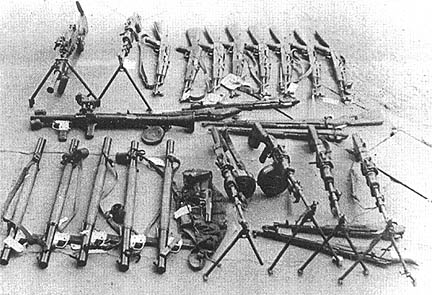 |
Just a few of the weapons that were captured after the battle of Soui Cut by the 3rd Bn, 22nd Inf "Regulars." The condition of the weapons shows that the Viet Cong were well equipped. (Photo by MAJ Bernard Rhees) |
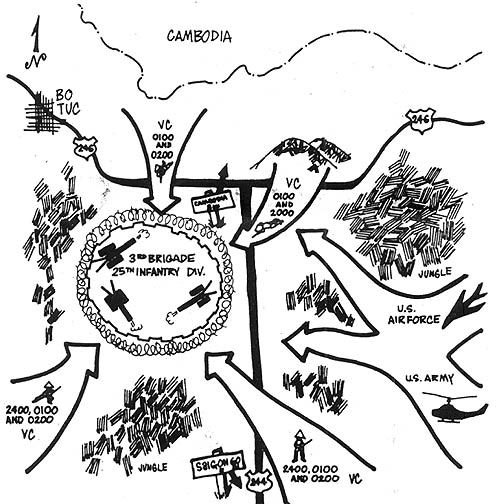 |
| This is a map of the 10-hour battle of Soui Cut. At least 382 Viet Cong of the 271st and 272nd Main Force VC Regiments were killed in their abortive attempt to overrun the fire support base. (See story Page 1) |
Thanks to:
Andy Barber, 2nd Bn., 27th Inf.
for sharing this issue,
Kirk Ramsey, 2nd Bn., 14th Inf. for creating this page.
This page last modified
01-08-2006
©2006 25th Infantry Division Association. All rights reserved.